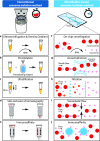Challenges and opportunities in exosome research-Perspectives from biology, engineering, and cancer therapy
- PMID: 31069333
- PMCID: PMC6481742
- DOI: 10.1063/1.5087122
Challenges and opportunities in exosome research-Perspectives from biology, engineering, and cancer therapy
Abstract
Exosomes are small (∼30-140 nm) lipid bilayer-enclosed particles of endosomal origin. They are a subset of extracellular vesicles (EVs) that are secreted by most cell types. There has been growing interest in exosome research in the last decade due to their emerging role as intercellular messengers and their potential in disease diagnosis. Indeed, exosomes contain proteins, lipids, and RNAs that are specific to their cell origin and could deliver cargo to both nearby and distant cells. As a result, investigation of exosome cargo contents could offer opportunities for disease detection and treatment. Moreover, exosomes have been explored as natural drug delivery vehicles since they can travel safely in extracellular fluids and deliver cargo to destined cells with high specificity and efficiency. Despite significant efforts made in this relatively new field of research, progress has been held back by challenges such as inefficient separation methods, difficulties in characterization, and lack of specific biomarkers. In this review, we summarize the current knowledge in exosome biogenesis, their roles in disease progression, and therapeutic applications and opportunities in bioengineering. Furthermore, we highlight the established and emerging technological developments in exosome isolation and characterization. We aim to consider critical challenges in exosome research and provide directions for future studies.
Figures



Similar articles
-
Challenges in Exosome Isolation and Analysis in Health and Disease.Int J Mol Sci. 2019 Sep 21;20(19):4684. doi: 10.3390/ijms20194684. Int J Mol Sci. 2019. PMID: 31546622 Free PMC article. Review.
-
Mini Review: Current Trends and Understanding of Exosome Therapeutic Potential in Corneal Diseases.Front Pharmacol. 2021 Aug 19;12:684712. doi: 10.3389/fphar.2021.684712. eCollection 2021. Front Pharmacol. 2021. PMID: 34489693 Free PMC article. Review.
-
Exosomes: Nomenclature, Isolation, and Biological Roles in Liver Diseases.Biomol Ther (Seoul). 2023 May 1;31(3):253-263. doi: 10.4062/biomolther.2022.161. Biomol Ther (Seoul). 2023. PMID: 37095734 Free PMC article. Review.
-
Exosomes: Diagnostic and Therapeutic Implications in Cancer.Pharmaceutics. 2023 May 11;15(5):1465. doi: 10.3390/pharmaceutics15051465. Pharmaceutics. 2023. PMID: 37242707 Free PMC article. Review.
-
Engineered and Mimicked Extracellular Nanovesicles for Therapeutic Delivery.Nanomaterials (Basel). 2024 Apr 6;14(7):639. doi: 10.3390/nano14070639. Nanomaterials (Basel). 2024. PMID: 38607173 Free PMC article. Review.
Cited by
-
Extracellular Vesicle Proteins and MicroRNAs as Biomarkers for Traumatic Brain Injury.Front Neurol. 2020 Jul 16;11:663. doi: 10.3389/fneur.2020.00663. eCollection 2020. Front Neurol. 2020. PMID: 32765398 Free PMC article. Review.
-
Research progress on the role of adipocyte exosomes in cancer progression.Oncol Res. 2024 Sep 18;32(10):1649-1660. doi: 10.32604/or.2024.043482. eCollection 2024. Oncol Res. 2024. PMID: 39308520 Free PMC article. Review.
-
Clinical applications of stem cell-derived exosomes.Signal Transduct Target Ther. 2024 Jan 12;9(1):17. doi: 10.1038/s41392-023-01704-0. Signal Transduct Target Ther. 2024. PMID: 38212307 Free PMC article. Review.
-
Exosomes and ultrasound: The future of theranostic applications.Mater Today Bio. 2023 Jan 20;19:100556. doi: 10.1016/j.mtbio.2023.100556. eCollection 2023 Apr. Mater Today Bio. 2023. PMID: 36756211 Free PMC article. Review.
-
Extracellular vesicles: The next generation in gene therapy delivery.Mol Ther. 2023 May 3;31(5):1225-1230. doi: 10.1016/j.ymthe.2023.01.021. Epub 2023 Jan 25. Mol Ther. 2023. PMID: 36698310 Free PMC article. Review.
References
Publication types
LinkOut - more resources
Full Text Sources
Other Literature Sources
Research Materials

